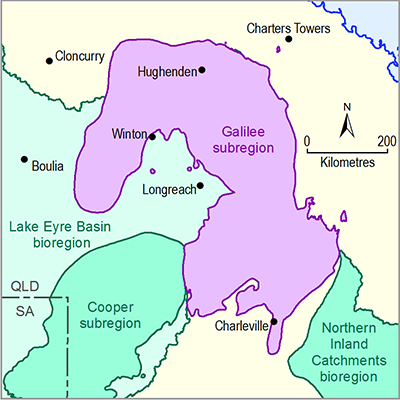About the subregion
This synthesis presents key findings from the bioregional assessment of the Galilee subregion (Figure 2), part of the Lake Eyre Basin bioregion. The subregion straddles the Great Dividing Range and extends west and north into the Lake Eyre surface water catchment and Flinders-Norman river basins. A diversity of ecological communities and species are adapted to the subregion’s arid and semi-arid ecosystems.
The subregion covers about 248,000 km2; however, the total area investigated for this assessment (the assessment extent) is about 612,000 km2, as it includes groundwater and surface water systems that extend beyond the subregion boundary (Figure 1).
This assessment considered two futures: the baseline, which has no existing coal resource development, and the coal resource development pathway (Box 1), which includes 17 additional coal resource developments, of which seven had sufficient information to be modelled (Table 1). This assessment mainly focused on the potential cumulative impacts of these seven coal mines on water and water-dependent assets.
Potential hydrological changes
Regional-scale hydrological modelling identified potential changes in groundwater and streamflow due to seven modelled additional coal resource developments. A zone of potential hydrological change (Figure 1, Box 5) identified the area potentially impacted by these seven mines. The zone covers 14,030 km2 and includes 6285 km of streams, most of which are temporary streams.
Potential impacts on ecosystems and assets
Potential impacts to groundwater, surface water and water-dependent assets are mostly restricted to the Belyando and Suttor river basins, the location of the seven modelled coal mines (Figure 3). The largest groundwater drawdowns are in the coal-bearing layer, but very few assets source groundwater from this layer. Smaller drawdowns are expected in the Cenozoic alluvium (near-surface aquifer) and Clematis Group aquifers. The main Great Artesian Basin (GAB) aquifers of the Eromanga Basin are not predicted to be impacted.
Source aquifers for 188 of the 1559 springs in the assessment extent have at least a 5% chance of exceeding 0.2 m drawdown, including for 181 springs in the Doongmabulla Springs complex. In the zone, 8% of the 2801 km of groundwater-dependent streams show some level of risk of ecological and hydrological changes (Box 10), including parts of Native Companion, North and Sandy creeks, and the Belyando and Carmichael rivers. Some level of risk of ecological and hydrological changes was found for up to 3% of groundwater-dependent vegetation along floodplains associated with Alpha, North, Sandy and Tallarenha creeks, and the Belyando, Suttor and Carmichael rivers.
Of the 241 ecological assets potentially impacted due to modelled additional coal resource development, 148 are considered ‘more at risk of hydrological changes’ relative to other assets (Box 11). These include potential habitat of 12 threatened species and two threatened ecological communities listed under the Commonwealth’s Environment Protection and Biodiversity Conservation Act 1999 (EPBC Act).
One surface water right, extracting from the Belyando River and a tributary of Native Companion Creek, and five groundwater economic assets are potentially impacted due to modelled additional coal resource development. Three of these groundwater assets are associated with the Clematis Group aquifer, including water access rights near the town of Jericho. However, it is very unlikely that any of the economic assets associated with the Clematis Group aquifer will experience more than 2 m of drawdown.
The greatest confidence in results is in those areas that are very unlikely to be impacted. Where potential impacts have been identified, further local-scale modelling may be required to determine the likelihood and magnitude of impacts.
In bioregional assessments, results are reported for two potential futures: The difference in results between the coal resource development pathway and baseline is the change that is primarily reported in a bioregional assessment. This change is due to the additional coal resource development. The coal resource development pathway for the Galilee subregion was based on information available as of December 2014. However, coal resource development proposals may change over time or be withdrawn, or timing of developments may change. Factors such as climate change or land use were held constant between the two futures. Although actual climate or land use may differ, the effect on results is expected to be minimal as the assessment focused on the difference in the results between the coal resource development pathway and baseline, minimising the impacts of changes that occur in both futures.Box 1 Investigating two potential futures

Product Finalisation date
- Executive summary
- Explore this assessment
- About the subregion
- How could coal resource development result in hydrological changes?
- What are the potential hydrological changes?
- What are the potential impacts of additional coal resource development on ecosystems?
- What are the potential impacts of additional coal resource development on water-dependent assets?
- How to use this assessment
- Building on this assessment
- References and further reading
- Datasets
- Contributors to the Technical Programme
- Acknowledgements
- Citation
